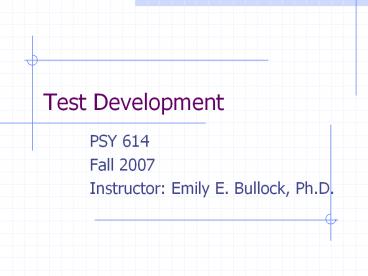Test Development PowerPoint PPT Presentation
Title: Test Development
1
Test Development
- PSY 614
- Fall 2007
- Instructor Emily E. Bullock, Ph.D.
2
Five Stages of Test Development
- Test Conceptualization
- Test Construction
- Test Tryout
- Item Analysis
- Test Revision
3
Stage 1 Test Conceptualization
- There ought to be a test designed to
- measure __________ in _______ way.
- Some Test Conceptualization Questions
- What is the test designed to measure?
- What is the objective of the test?
- Is there a need for this test?
- Who will use this test?
- Who will take this test?
- What content will the test cover
- How will the test be administered?
4
Stage 1 Test Conceptualization
- (More Test Conceptualization Questions)
- What is the ideal format of the test?
- Should more than one form of the test be
developed? - What special training will be required of test
users for administering or interpreting this
test? - What types of responses will be required by test
takers? - Who benefits as a results of an administration of
this test? - Is there any potential for harm as a result of an
administration of this test? - How will meaning be attributed to scores on this
test?
5
Stage 2 Test Construction
- Selecting Item Types
- Scale Construction
- Rational
- Empirical
- Rational-Empirical
- Response Sets
- Social Desirability
- Random Responding
- Dissimulation
- Response Style
6
Stage 2 Test Construction
- Writing the Items
- What range of content should the items cover?
- How many items should be written?
- A typical standardized, multiple choice test
should begin with an item pool two times the
intended size of the the final test items - Considerations should be made for reading level,
grammar used, bias in wording, length of the
item, and more. - Scoring the Items
7
Stage 3 Test Tryout
- Use people similar in critical respects to the
people for whom the test was designed - 5 to 10 test takers per item
- Begin Item Analysis process to create final
version of test
8
Step 4 Item Analysis
- Item Analysis set of procedures for analyzing
responses to test items and the relationships
between item characteristics and test
characteristics - What is a good test item?
9
A Good Test Item
- Is reliable and valid
- Helps to discriminate test takers
- High scorers on the test as a whole get the item
correct - Low scorers on the test as a whole get the item
incorrect
10
Step 4 Methods of Item Analysis
- Item Difficulty Index
- Item Validity Index
- Item Reliability Index
- Item Discrimination Index
- Item Response Theory
- Test Item Bias
- Qualitative Item Analysis
11
Step 4 Item Analysis Item Difficulty Index
- Item Difficulty Index an index of an items
difficulty is obtained by calculating the
proportion of the total number of test takers who
got the item correct - p7 would be read item difficulty index for item
7 - p ranges from 0 (no one got item correct) to 1
(everyone got item correct) - If 75 of 100 test takers got item 7 correct then
- p7 .75 because 75/100 equals .75
12
Step 4 Item Analysis Item Difficulty Index
- Difficulty is relative to the item and the test
taking population - Provides a common measure of the difficulty of
test items that measure completely different
domains - Has little impact on reliability or validity of a
test - Item Difficulty impacts the variability of test
scores and precision with which test scores
discriminate among different groups of test
takers - p of .5 is optimum for test items
13
Step 4 Item Analysis Item Discrimination Index
- Item Discrimination Measures indicate how
adequately an item separates or discriminates
between high scorers and low scorers on an entire
test - It is a measure of the difference between the
proportion of high scorers answering an item
correctly and the proportion of low scorers
answering the item correctly
14
Item Validity and Reliability Indices
- Item Validity Index method of assessing the
criterion-related validity through a formula that
utilizes the item-score standard deviation and
the correlation between the item score and the
criterion score - Item Reliability Index method of assessing the
internal consistency of a test using the
item-score standard deviation and the correlation
between the item score and the total test score
15
Step 4 Item Analysis Item Response Theory
- Provides informative and interpretable
information about - Item characteristics
- Ability levels needed to pass test items
- Test scores
- Does not address reliability and validity of a
test but information for understanding how
individual differences affect the behavior of an
individuals performance on a specific item - Provides information that is sample non-dependant
16
Step 4 Item AnalysisTest Item Bias
- Consensus that it is virtually impossible to
assess item bias by examining item content - Use the concepts of validity to determine whether
the test measures the same thing for different
groups in the population
17
Step 4 Item Analysis Qualitative Item Analysis
- Gaining information about a test takers
experience taking the test or an experts opinion
of the test - Types of Qualitative Item Analysis
- Test-taker questionnaire
- Think-aloud test administration
- Expert Panels
18
Stage 5 Test Revision
- Based on your item analysis, reliability
estimates, and validity information determine
which items form the final test - The test may be revised multiple times as it is
goes through the test tryout, item analysis, test
revision loop. - Norm and Standardize
- Cross Validation
19
After the Test is Developed
- Writing the Manual
- Test Publication
- Professional journals
- Publishing Companies
- Marketing and Rights
- Additional Revision
- Implications of revision

